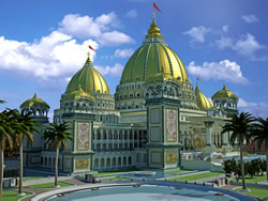ISKCON’s Flagship Temple Announces Planetarium Design
By Madhava Smullen | Ноя 14, 2010

On October 10th, the Vedic Planetarium Cosmology Project, under the direction of the Governing Body Commission (GBC), announced that they had made a final decision regarding the design of the Vedic cosmology presentation that will appear in the main dome of The Temple of the Vedic Planetarium in Mayapura, India.
A little before the 2010 Gaura Purnima festival in Mayapur, two devotees, Carana-renu Dasi and Antardwipa Dasa, both submitted proposals to the chairman of the temple project Ambarisa Dasa for what ISKCON Founder Srila Prabhupada had planned back in 1976 as “a huge, detailed model of the universe as described in the fifth canto of Srimad Bhagavatam.”
Members of the Vedic Planetarium Cosmology Project (VPCP), led by scholar Ravindra Svarupa Dasa, were impressed by the high degree of knowledge, intelligence, ingenuity, and sheer industry used in both submissions.
Both models were based upon the framework Srila Prabhupada had given his disciples for what would be his most monumental project. This framework was to remain no matter which proposal was chosen.
It of course began with a massive dome surmounting the temple room, beneath which would be displayed the cosmology of the Srimad-Bhagavatam.
The Bhagavatam’s description of the universe is quite startling to those raised on modern astronomical ideas: it tells of orbiting heavenly bodies stacked one above the other over Bhumandala, the earthly plane, and has the Moon farther away than the Sun. Also, sandwiched between the Moon’s orbital plane and that of the next higher planet, Venus, are the naksatras, the visible stars that form the twenty-eight lunar mansions.
In the Vedic Planetarium as outlined by Srila Prabhupada, this vision would be displayed through two different presentations.
One would be a fixed presentation, depicting the universe’s hierarchy of abodes through painting, sculpture, and other mediums worked into the architectural features of the temple. Bhumandala would be depicted on the temple room floor with terrazzo faux marble flooring. Visitors, ascending through diorama galleries set in the dome’s inner surface, would tour higher and higher planets, retracing the ascent to the spiritual world of the devotee Gopa Kumara as narrated in the Brihad Bhagavatamrita.
The other presentation would be a rotating three-dimensional model of the universe in the form of a two-hundred feet across chandelier, depending from the dome’s apex to fill the space above the Deities.
After deliberating for months on the two submissions based on this framework, and consulting the Srimad-Bhagavatam and Srila Prabhupada’s directions, the VPCP chose Antardwipa Dasa’s proposal.
The accepted proposal will interlace the moving display and the fixed presentation together, reinforcing each other and creating a powerful unified impression.
The moving model depicts the heavenly bodies circling in their obits above the Bhumandala floor, arranged one above the other according to the sequence and vertical distances given in the Bhagavatam.
The mechanism proposed to realize this display will have at its core a fixed pole, depending from Dhruvaloka at the dome’s apex. Each planet will orbit the axis at its prescribed height, suspended upon a pair of invisibly fine wires.
The three groups of fixed constellations—the circle of naksatras (lunar mansions) just above the Moon, the circle of taras between Mercury and Mars, and the circle of the saptarishis (Big Dipper) just below Dhruva—will be portrayed by laser projection.
The lower end of the central axle will be held stable by twelve cables anchored at equal intervals around the dome’s lowest circumference. Viewers at the center of the Bhumandala floor will see the heavens divided by the cables into the twelve houses of the Vedic horoscope.
The alternative model of the cosmos, which the committee did not select, would have featured a conventional earth-based view of the heavens used in planetariums all over the world, yet also in line with the Srimad-Bhagavatam’s description. Esentially, in this alternative model, the Bhumandala floor would have belonged with the fixed tour presentation of the heavens rather than the moving cosmos presentation.
In his report, Ravindra Svarupa says that the plan that was accepted provides “A moving model to display the vertical sequence of the heavenly bodies (svargaloka) between Bhumandala and Dhruvaloka, as well as the orbit of the Sun, exactly as described by Sukadeva Gosvami in Srimad Bhagavatam (5.21-23).”
The report calls the chosen plan “insightful, ingenious, a brilliant tour de force of reason and logic based on sastra,” and says that the Vedic Planetarium Cosmology Project made its selection because “It comes closest to fulfilling Srila Prabhupada’s desire for the temple.”
Of course, this decision is just the beginning. There’s a lot of work ahead now for the Temple of the Vedic Planetarium, which was inaugurated this February—it isn’t expected to become a fully functional temple until 2016, and detail work will continue on for another four years after that.















